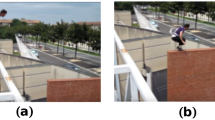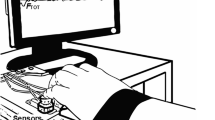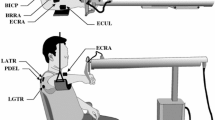Abstract.
The question of degrees of freedom in the control of multijoint movement is posed as the problem of discovering how the motor control system constrains the many possible combinations of joint postures to stabilize task-dependent essential variables. Success at a task can be achieved, in principle, by always adopting a particular joint combination. In contrast, we propose a more selective control strategy: variations of the joint configuration that leave the values of essential task variables unchanged are predicted to be less controlled (i.e., stabilized to a lesser degree) than joint configuration changes that shift the values of the task variables. Our experimental task involved shooting with a laser pistol at a target under four conditions. The seven joint angles of the arm were obtained from the recorded positions of markers on the limb segments. The joint configurations observed at each point in normalized time were analyzed with respect to trial-to-trial variability. Different hypotheses about relevant task variables were used to define sets of joint configurations ("uncontrolled manifolds" or UCMs) that, if realized, would leave essential task variables unchanged. The variability of joint configurations was decomposed into components lying parallel to those sets and components lying in their complement. The orientation of the gun's barrel relative to a vector pointing from the gun to the target was the task variable most successful at showing a difference between the two components of joint variability. This variable determines success at the task. Throughout the movement, not only while the gun was pointing at the target, fluctuations of joint configuration that affected this variable were much reduced compared with fluctuations that did not affect this variable. The UCM principle applied to relative gun orientation thus captures the structure of the motor control system across different parts of joint configuration space as the movement evolves in time. This suggests a specific control strategy in which changes of joint configuration that are irrelevant to success at the task are selectively released from control. By contrast, constraints representing an invariant spatial position of the gun or of the arm's center of mass structured joint configuration variability in the early and mid-portion of the movement trajectory, but not at the time of shooting. This specific control strategy is not trivial, because a target can be hit successfully also by controlling irrelevant directions in joint space equally to relevant ones. The results indicate that the method can be successfully used to determine the structure of coordination in joint space that underlies the control of the essential variables for a given task.
Similar content being viewed by others
Author information
Authors and Affiliations
Additional information
Electronic Publication
Rights and permissions
About this article
Cite this article
Scholz, J., Schöner, G. & Latash, M. Identifying the control structure of multijoint coordination during pistol shooting. Exp Brain Res 135, 382–404 (2000). https://doi.org/10.1007/s002210000540
Received:
Accepted:
Issue Date:
DOI: https://doi.org/10.1007/s002210000540




